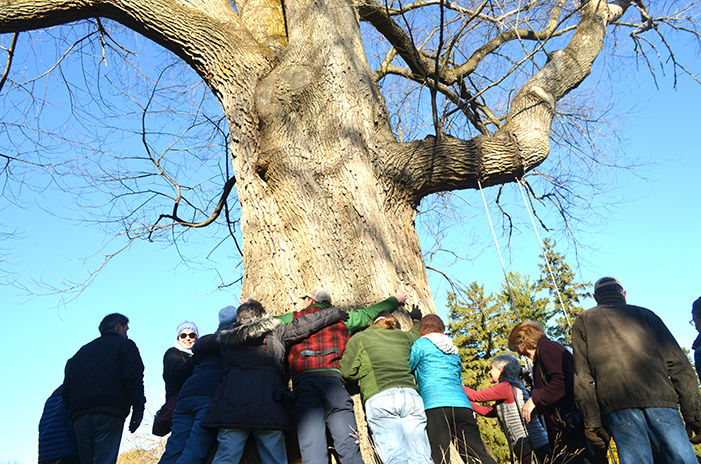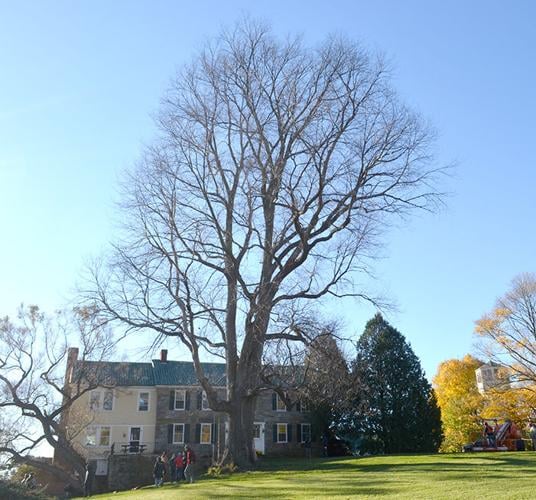Under a brilliant November sun, a crowd gathered on a Charlotte lawn Tuesday morning to say goodbye to a tree that had seen more years than anyone else there. The largest elm in the Northeast recently died of the infamous Dutch elm disease, having stood for an estimated 300 years.
The tree, on the Garrett property between Town Farm and Converse Bays, was a slippery elm, rarer than the American elm and also devastated by periodic sweeps of Dutch elm disease. Charlotte Tree Warden Larry Hamilton, who died earlier this fall, had brought the tree to the attention of The Nature Conservancy, which has been working to restore elm populations in Vermont. “Fortunately, the Garrett family was very interested in working with us, they were very cooperative and enthusiastic about the project,” said Nature Conservancy Critical Lands and Conservation Science Director Rose Paul.
“This (elm) was particularly unique in that it was so old, so big, and that it was a survivor,” noted Nature Conservancy Director of Communications and External Affairs Director Eve Frankel.
Although the Nature Conservancy was not able to secure cuttings from the Charlotte elm before it died, the organization continues to introduce similar long-lived trees’ hardy traits into the natural population. Such trees would already have survived multiple waves of Dutch elm disease, noted Paul. The Nature Conservancy is working to cross-pollinate Vermont’s cold-hardy elms with other, disease-tolerant elms from further south in New Jersey and Delaware. The goal, noted Paul, is to produce trees that are robust to Vermont’s cold winters while possessing disease-tolerant traits.
“It’s great in an ecological sense because elm trees used to grow to be very long-lived, and very tall,” said Paul. “They were one of the most dominant trees both on our floodplains and in our forests.” This allowed the trees to play in important ecological role, both in life and in death. Living elm trees are flood-tolerant and help to maintain floodplain soils; they also shade streams, contributing to aquatic habitats for life there as well. And when the trees die, they become “big apartment trees for all kinds of wildlife,” explained Paul. With their peeling bark, cavities, and hollows, these dead trees provide habitat for birds, mammals, and insects.
But when elm trees die at a young age of Dutch elm disease, they never reach the canopy and don’t play the same role as older, larger trees. “They just don’t provide that extensive habitat anymore,” said Paul. And though elm trees remain in areas where The Nature Conservancy works in the Connecticut River watershed, but they’re either young and small or already dead. In northern Vermont, silver maples now dominate the forest. Domination by a single species leaves these ecosystems walking a dangerous tightrope, noted Paul.
“It’s susceptible to the next bad invasive disease or insect that may come along, when you’ve got all your eggs in one basket,” Paul noted. Diversity of species in the forest provides an ecosystem a variety of ways to face challenges that may arise – to provide disease resistance as well as confront climate change.
Trees like the Charlotte elm – “big and old – can play a role by contributing their disease-tolerance genes to our local elm populations,” said Paul. “Unfortunately, The Nature Conservancy did not find out about this particular elm in time.”
But even though the Charlotte elm’s cuttings won’t be part of this project, the tree will still contribute to The Nature Conservancy’s efforts. When the tree died, it would have to be removed, and John Monks was contacted. Monks, of Vermont Tree Goods, is a woodworker who is skilled in the removal of such enormous old trees. Frankel credits property owner David Garrett with thinking to contact Monks, who specializes not only on “disassembling” such trees, but also in repurposing their wood, holes, gnarls and all, into unique pieces of furniture such as beds and tables.
Monks plans to donate part of the proceeds from the furniture’s sale to The Nature Conservancy, to aid in their elm conservation efforts, explained Frankel. These efforts include propagating and growing disease-hardy elms and planting them across the floodplains of Vermont, Massachusetts, New Hampshire, and Connecticut. Paul explained that The Nature Conservancy’s work – a partnership with the U.S. Forest Service – includes planting the offspring of disease-tolerant elms on Vermont’s floodplains to restore these forests, and to bring back their hardy elms.
The largest such project is in northeastern Vermont, where The Nature Conservancy is planting 5,000 elms in the Connecticut River watershed over the course of five years. Other, smaller projects include earlier elm plantings at such local sites as Shelburne’s LaPlatte Nature Park and a natural area in Charlotte. These smaller plantings yielded insights that now aid in the success of larger-scale plantings in other forests.
“The big vision is that the trees that we have planted, that survive, will continue to produce flowers and seeds for many generations,” said Paul. Such trees will then cross-pollinate with local trees, and “over time this trait of disease tolerance will spread throughout our local populations of elms.”
Meanwhile, the Charlotte elm’s wood is on its way to Bristol, where Monks and his team will kiln-dry and age it. Its products, each branded with a silhouette of the grand elm as it stood, are expected to start becoming available in the spring.
In the cold wind of Tuesday morning, Garrett neighbor Erick Crockenberg stood before the tree and recalled a day 20 years ago when Larry Hamilton recruited a then-six-year-old Crockenberg to come help him measure the mighty elm next door. Crockenberg noted that he, too, hopes one day to be the man in his 60s, bringing a young child outside to instill a similar love and awe of nature. The tree, growing as it did from a seed some distant day in centuries past, served to remind us of great potential, said Crockenberg.
“Great champions were once tiny.”














(0) comments
Welcome to the discussion.
Log In
Keep it clean. Please avoid obscene, vulgar, lewd, racist or sexual language.
PLEASE TURN OFF YOUR CAPS LOCK.
Don't threaten. Threats of harming another person will not be tolerated.
Be truthful. Don't knowingly lie about anyone or anything.
Be nice. No racism, sexism or any sort of -ism that is degrading to another person.
Be proactive. Use the "Report" link on each comment to let us know of abusive posts.
Share with us. We'd love to hear eyewitness accounts, the history behind an article.